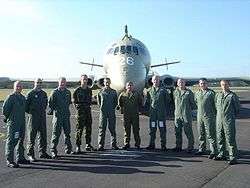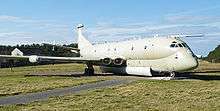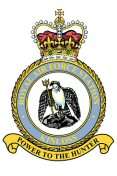RAF Kinloss
Kinloss Barracks | |||||||||||
|---|---|---|---|---|---|---|---|---|---|---|---|
|
Motto: Power to the Hunter | |||||||||||
|
IATA: FSS – ICAO: EGQK – WMO: 03066 | |||||||||||
| Summary | |||||||||||
| Airport type | Military | ||||||||||
| Owner | Ministry of Defence | ||||||||||
| Operator | Royal Air Force, British Army | ||||||||||
| Location | Kinloss | ||||||||||
| Built | 1938 | ||||||||||
| In use |
1939 - 2012 (RAF) 2012 - (British Army) | ||||||||||
| Commander | |||||||||||
| Occupants |
| ||||||||||
| Elevation AMSL | 22 ft / 7 m | ||||||||||
| Coordinates | 57°38′58″N 003°33′38″W / 57.64944°N 3.56056°WCoordinates: 57°38′58″N 003°33′38″W / 57.64944°N 3.56056°W | ||||||||||
| Map | |||||||||||
 EGQK Location in Moray | |||||||||||
| Runways | |||||||||||
| |||||||||||
RAF Kinloss is a former Royal Air Force station located near the village of Kinloss, on the Moray Firth in the north of Scotland.
The RAF station opened on 1 April 1939 and served as a training establishment during the Second World War. After the war it was handed over to Coastal Command to watch over Russian ships and submarines in the Norwegian Sea. Until 2010 it was the main base for the RAF's fleet of Nimrod MR2 maritime patrol aircraft. It was intended that the MR2 would be replaced by the Nimrod MRA4, but the MRA4 was cancelled in the Strategic Defence and Security Review of October 2010. This meant that Kinloss was no longer required by the RAF. Regular flying operations ceased on 31 July 2011. However, the runways will be maintained to be used as a relief landing site, e.g. from RAF Lossiemouth.[1]
In November 2011 the Ministry of Defence and 12 (Air Support) Engineer Group announced that 930 Service personnel from 39 Engineer Regiment (Air Support) would move from Waterbeach Barracks, near Cambridge, to Kinloss in summer 2012.[2][3] First units of 39 Engineer Regiment (Air Support) arrived in June 2012, with the majority expected by July.[4]
On 26 July 2012 at 1200 the RAF Ensign was lowered for the last time, and replaced by the flag of 39 Engineer Regiment (Air Support), Royal Engineers, to become Kinloss Barracks.[5]
History
Second World War

Construction work began in the spring of 1938 to establish RAF Kinloss as a pilot training school. Land was requisitioned from local farms Easter Langcot, Muirton and Kinloss as well as Kinloss House and on 1 April 1939 with No. 14 Flying Training School RAF (FTS) on camp and No. 45 Maintenance Unit RAF soon to follow, RAF Kinloss opened.
In 1939, 14 FTS moved south and were replaced by 19 Operational Training Unit (OTU) training bomber crews for the offensive.
The station defences were gradually established and by May 1940, Group Captain Jarman reported that the defence of Kinloss was in order.
Throughout the majority of the war 19 Operational Training Unit was the primary training unit. Between July 1940 and June 1941 it flew over 22,073 hours almost four times the rate achieved by 14 FTS the previous year.
Cold War
Not long after VE Day 19 OTU was disbanded and the arrival of 6 Coastal OTU saw the beginning of Kinloss's association with maritime operations, an association that continues to this day.
The wartime Avro Lancaster was adapted for anti-submarine and search and rescue duties and RAF Kinloss changed from a bomber training unit, to a Coastal Command base training maritime aircrew. Its personnel now also included National Servicemen.
19 (C)OTU was split into No. 236 Operational Conversion Unit RAF and the School of Maritime Reconnaissance in 1947 with 236 OCU remaining at Kinloss. A further change in 1956 saw the units re-combine as the Maritime Operational Training Unit (MOTU), which remained at Kinloss until 1965. During the Cold War Kinloss squadrons carried out anti-submarine duties, locating and shadowing Russian naval units. In 1951 217 Squadron was resurrected with Lockheed Neptune MR1 aircraft to cover the Maritime reconnaissance and Search and Rescue roles pending the further development of the Avro Shackleton aircraft. It was also prominent in Operation Snowdrop, supplying food to cut off villages and livestock fodder to isolated crofts in Scotland, during the winter of 1954/5.[6] The squadron was upgraded with MR2 versions of the Neptune in 1956 only to be disbanded again in July 1956. In July 1962, the station received one of its highest honours, the Civic Freedom of the Royal and Ancient Burgh of Forres, allowing Kinloss personnel the right to march through the burgh with swords drawn. This was the first time any military unit had been so honoured by Forres throughout the burgh's 1,400-year history.
In 1972 and 1976 the new Hawker Siddeley Nimrod demonstrated its capabilities when it flew surveillance sorties over Iceland's disputed fishing limits, providing support for the Royal Navy and British trawlers in the Cod Wars. For much of the period No's 120, 201, and 206 Squadrons were the main Nimrod units.
In November 1980 two pilots, Royal Australian Air Force Flight Lieutenant Noel Anthony and RAF Flying Officer Stephen Belcher were killed when their Nimrod aircraft struck birds on take off and crashed in woods to the east of Kinloss airfield. The remainder of the crew survived. Anthony was awarded the Air Force Cross and Belcher the Queen's Commendation for Valuable Service in the Air.[7]
After the Argentines invaded the Falkland Islands in 1982, Nimrod MR2's adapted for air-to-air refuelling, were deployed to Ascension Island in the South Atlantic.
Post-Cold War
In 1991 Nimrod aircraft deployed to the Persian Gulf as an integral component of the coalition forces to recapture Kuwait. Furthermore, Nimrods have been actively involved in the Adriatic as part of the United Nations peace-keeping force. More recently in 2003, the Nimrod played a pivotal role in Op TELIC. The station's high level of involvement in operational activities led to RAF Kinloss being awarded the coveted Stainforth Trophy for the best operational performance in 2004.

In April 2005, 206 Squadron was disbanded as part of a defence review the previous year. The base was used for the 2005 Edinburgh and South Scotland Wing Air Cadet Annual Summer Camp.
On 2 September 2006, 12 Nimrod crew members from 120 Squadron crew 3 and 2 observers were killed when their Nimrod, serial number XV230, exploded over Afghanistan.
No. 325 Expeditionary Air Wing RAF (EAW) was formed at the station on 1 April 2006. The wing encompasses most of the non-formed unit personnel on station. The EAW does not include the flying units at the station.
Aeronautical Rescue Coordination Centre
RAF Kinloss became home to the UK Aeronautical Rescue Coordination Centre (ARCC) in 1997 when the ARCC’s located in Edinburgh and Plymouth were combined into one centre covering the whole UK Search and Rescue Region. The ARCC was responsible for tasking all UK search and rescue (SAR) assets such as RAF, Royal Navy and coastguard helicopters, fixed wing aircraft and mountain rescue teams. It coordinated a wide range of activities associated with SAR operations, including overland search planning, refuelling arrangements, airspace considerations, multi-agency communications, and co-ordination with other emergency services. The ARCC included the UK Mission Control Centre (UKMCC) which is the facility responsible for the detection and notification of emergency distress beacon alerts through the International Cospas-Sarsat Programme, which is able to detect beacon activations worldwide through a network of satellites.[8]
Despite the transfer of Kinloss from the RAF to the British Army in 2012, the ARCC remained at the station. However, in December 2014 the Ministry of Defence announced that the ARCC at Kinloss would close and be relocated to the Maritime and Coastguard Agency’s National Maritime Operations Centre located in Fareham, Hampshire. The Kinloss ARCC closed on 31 March 2016, with 27 RAF personnel being redeployed to other RAF stations, or leaving the service, and 10 civilian jobs being lost from Kinloss.[9][10]
Mountain Rescue Team
The RAF Kinloss Mountain Rescue Team (MRT) was established in the 1940s as part of the RAF Mountain Rescue Service. With the closure of Kinloss as an RAF base in July 2012, the RAF Kinloss Mountain Rescue Team (MRT) was renamed the RAF Lossiemouth MRT. The team continued to operate from their existing purpose built base at Kinloss for over two years, until they moved into a 'D' Flight No. 202 Squadron hangar at Lossiemouth in February 2015.[11][12]
Closure of RAF Station

In December 2009, the Ministry of Defence announced the retirement of the Nimrod MR2 by March 2010, twelve months earlier than originally planned. It was also announced that the in-service date of its replacement, the Nimrod MRA4, would be delayed until Autumn 2012, with the aircraft expected to start arriving at Kinloss in February 2010.[13] This was delayed again in June 2010 when the MoD announced that the MRA4 would arrive at the end of 2010.
With Nimrod MR2 operations having ended in March 2010, the Strategic Defence and Security Review in October 2010 revealed that the Nimrod MRA4 programme would in-fact be cancelled and that RAF Kinloss would close. Station commander Group Captain James Johnston said there had been disbelief when the announcement was made.[14] As a result, No. 120, No. 201 and 42(R) Squadron (the Operational Conversion Unit) were disbanded on 26 May 2011 at a ceremony attended by the station's Honorary Air Commodore, Prince Philip, Duke of Edinburgh.[15] The RAF station ceased to be operational on 31 July 2011.[16]
Kinloss Barracks
On 18 July 2011, the MoD announced that Kinloss would become a British Army barracks, with army units arriving in 2014 or 2015. A further announcement in November 2011 confirmed that 39 Engineer Regiment (Air Support) of the Royal Engineers would move from Waterbeach Barracks, near Cambridge, to Kinloss in July 2012. It was expected that 930 service personnel and their families would move at this time.[2][3] The number of army personnel based at Kinloss would be 41% down on the number of personnel which were present during the RAF's tenure.[17]
After 73 years as an RAF station, control of Kinloss transferred to the British Army at 1200 on 26 July 2012. A ceremony was attended by eight former RAF Kinloss station commanders, the last station commander Group Captain JJ Johnston, the Lord Lieutenant of Moray and invited guests. The RAF colours were lowered for the last time and British Army colours raised to mark the new chapter in Kinloss's history.[18] [5]
The airfield is maintained as a relief landing ground for aircraft based at nearby RAF Lossiemouth and continues to be used by Moray Flying Club and RAF No. 663 Volunteer Gliding Squadron operating the Vigilant T1. It cannot be booked by other aircraft as a diversion airfield or for refuelling stops.[19]
Operational units
Royal Air Force
- 663 Volunteer Gliding Squadron
British Army, Royal Engineers
- 39 Engineer Regiment (Air Support)[20]
- 10 Field Squadron (Air Support) - based at RAF Leeming
- 34 Field Squadron (Air Support)
- 53 Field Squadron (Air Support)
- 48 Field Squadron (Air Support)
- 60 Headquarters & Support Squadron (Air Support)
Suspected postwar radioactive contamination
Post WW2, Kinloss was used as one of the sites to break-up the excess of aircraft that the RAF now had, and recover what ever was recyclable. The site was chosen due to its remote location, and hence easy access to potential landfill sites which would be undisturbed by the majority of the public. The aircraft broken up included various components which had carried chemical weapons (including Sulphur mustard), and were all painted with fluorescent paint containing radium to allow the planes to be more easily operated at night. On removal, these contaminated items were buried in landfill sites either on the base or close to it.[21]
In 2004, with the development of a new water pipeline, a land quality assessment warned that sulphur mustard chemical weapons may be present within landfill and waste areas accessible to the public. The report stated that RAF Kinloss authorities believed there was a potential for chemical weapons agents and radiological contamination to be present in the ground:[21]
| “ | Any personnel involved in the ground investigation have the potential to be at risk from these contaminants. There are a number of anomalies present on the investigation area the have not been investigated, and in some areas it was not possible to conduct the geophysical survey due to heavy gorse cover | ” |
However, no trace of chemical weapons agents was found during the land quality assessment, although material contaminated with radium was removed from land near the base in 2004.[21]
After the 2004 documents became public in May 2012, it emerged that the Scottish Environment Protection Agency (SEPA) was investigating radioactive contamination at the site linked to the use of "glow in the dark paint" in WW2 aircraft. Moray MP Angus Robertson and Dunfermline and West Fife MP Thomas Docherty are both making representations to the Defence Secretary, Philip Hammond.[21]
References
- ↑ "Welcome to RAF Kinloss". Royal Air Force. 2012. Retrieved 21 May 2012.
- 1 2 "First tranche of Army unit moves confirmed". Ministry of Defence. Retrieved 10 November 2011.
- 1 2 "Waterbeach Forward - March 2012". Retrieved 24 March 2012.
- ↑ Moray gets ready to welcome the Army as advance party settles in, 19 June 2012.
- 1 2 "RAF colours come down at Kinloss airfield". BBC News. 26 July 2012. Retrieved 26 July 2012.
- ↑ Scottish Daily Express 19 January 1955
- ↑ Second Supplement to the London Gazette
- ↑ "RAF Search and Rescue (SARF) - ARCC". Royal Air Force. Royal Air Force. Retrieved 15 November 2016.
- ↑ Hendry, Ben (2 March 2016). "Kinloss rescue centre closure imminent". Press and Journal. Aberdeen Journals. Retrieved 15 November 2016.
- ↑ Foote, Chris (5 April 2016). "Scots search and rescue centre relinquishes responsibilities". STV News. STV. Retrieved 15 November 2016.
- ↑ "RAF Kinloss mountain rescue team 'to relocate'". BBC News. 8 July 2012. Retrieved 16 November 2016.
- ↑ "We follow in the footsteps of giants – RAF Lossiemouth Mrt are now based at RAF Lossiemouth at Last.". heavywhalley. 21 February 2015. Retrieved 16 November 2016.
- ↑ "RAF Kinloss will bear the brunt of defence cuts". STV News. 15 December 2009. Retrieved 19 November 2016.
- ↑ "RAF Kinloss to close as ministers cancel Nimrod order". BBC News. 19 October 2010. Retrieved 19 November 2016.
- ↑ "RAF Kinloss squadrons disbanded at final parade". BBC News. 26 May 2011. Retrieved 19 November 2016.
- ↑ "RAF Kinloss personnel stage Forres farewell march". BBC News. 24 May 2011. Retrieved 19 November 2016.
- ↑ "Army unit moving to former air base at Kinloss". BBC News. 10 November 2011. Retrieved 19 November 2016.
- ↑ "RAF Kinloss – The End Of An Era". Royal Air Force. Royal Air Force. 30 July 2012. Retrieved 19 November 2016.
- ↑ UK MIL AIP - EGQK. Ministry of Defence - No. 1 AIDU. 2015. p. 1.
- ↑ 39 Engineer Regiment (Air Support)
- 1 2 3 4 David Miller (20 May 2012). "Chemical weapon 'risk' at RAF Kinloss in Moray". BBC Scotland. Retrieved 20 May 2012.
External links
| Wikimedia Commons has media related to RAF Kinloss. |
- Website of former RAF Kinloss (Internet archive)
- Airport information for EGQK at World Aero Data. Data current as of October 2006.
- 39 Engineer Regiment (Air Support)

